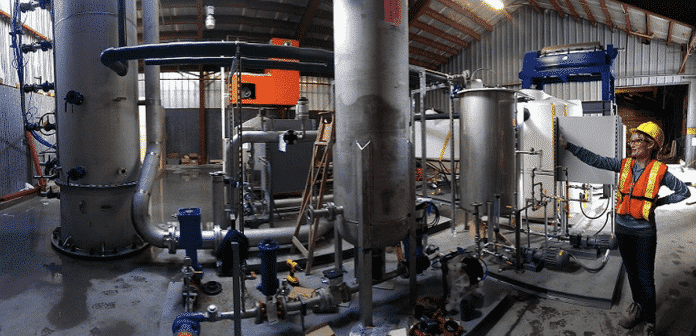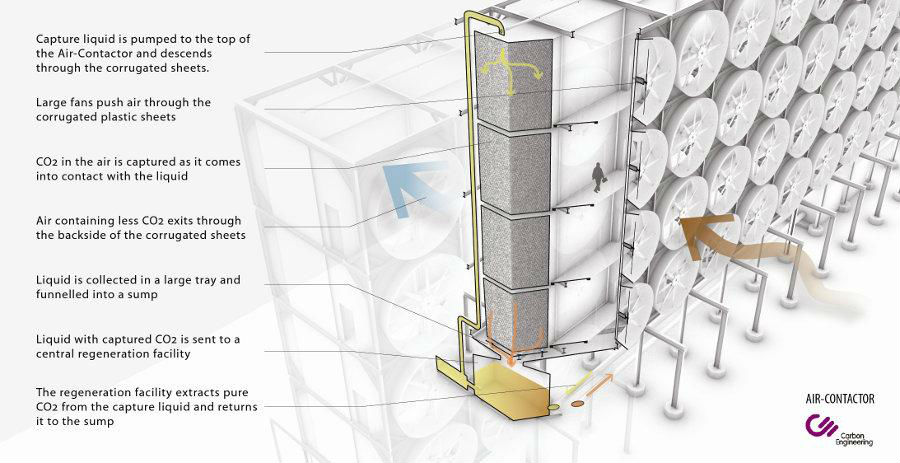Table Of Contents
Fuel from the air : Scientists developing technology to turn Carbon Dioxide in the air into fuel
Scientists in Canada are mounting an industrial carbon dioxide recycling plant that could one day suck CO2 out of the atmosphere and convert it into a zero-carbon e-diesel fuel.
A potentially game-changing breakthrough in artificial photosynthesis has been achieved with the development of a system that can capture carbon dioxide emissions before they are vented into the atmosphere and then, powered by solar energy, convert that carbon dioxide into valuable chemical products, including biodegradable plastics, pharmaceutical drugs and even liquid fuels.
Developed by tech start-up Carbon Engineering and partly funded by Bill Gates, the system will basically do the job of trees, but in places unable to host them, such as icy plains and deserts.
Scientists with the U.S. Department of Energy (DOE)’s Lawrence Berkeley National Laboratory (Berkeley Lab) and the University of California (UC) Berkeley have fashioned a hybrid system of semiconducting nanowires and bacteria that mimics the natural photosynthetic process by which plants use the energy in sunlight to produce carbohydrates from carbon dioxide and water.
The plan is to provide the technology that could one day produce environmentally friendly fuel to balance the renewable energy systems we have now. “How do you influence global transportation in 20 years in a way that is carbon neutral?” Geoff Holmes, business development Manager at Carbon Engineering, told Marc Gunther at The Guardian. “Cheap solar and wind are great at reducing emissions from the electricity. Then you are left with the transport sector.”
Carbon Engineering is one of a handful of companies around the world that are now set on coming up with ways to suck enough carbon dioxide out of the atmosphere to actually put a dent in the effects of climate change. There’s also the New York City-based start-up Global Thermostat, and Swiss-based Climeworks, which demonstrated earlier this year with Audi how its technology can detain carbon dioxide, and deliver it to German company Sunfire, where it was recycled into a zero-carbon diesel fuel.
While Climeworks’ revelation was impressive, what all three companies now need to do is figure out how to make their atmospheric carbon dioxide to fuel systems efficiently feasible. And this won’t be easy. One problem they’re going to have to conquer is the high cost of heating their carbon dioxide to around 400 degrees Celsius so they can process it properly. Another problem is that few investors are interested in giving them MONEY until they can prove that this is actually viable.
As Gunther reports for The Guardian, governments and private investors are not interested in PAYING anyone to come up with ways to simply suck carbon dioxide out of the environment, no matter how beneficial to the environment it might be. Plus even if someone was interested, they’d better be willing to fork out the billions of dollars it’s going to take to build a system that could actually make a visible difference to the world’s climate. These developers need to offer their investors something valuable in return, and the obvious answer is fuel.
“We believe our system is a revolutionary rise ahead in the field of artificial photosynthesis,” says Peidong Yang, a chemist with Berkeley Lab’s Materials Sciences Division and one of the leaders of this study. “Our system has the prospective to primarily change the chemical and oil industry in that we can produce chemicals and fuels in a totally renewable way, rather than extracting them from deep below the ground.”
Yang, who also holds appointments with UC Berkeley and the Kavli Energy NanoSciences Institute (Kavli-ENSI) at Berkeley, is one of three corresponding authors of a paper describing this research in the journal Nano Letters. The paper is titled “Nanowire-bacteria hybrids for unassisted solar carbon dioxide fixation to value-added chemicals.” The other corresponding authors and leaders of this research are chemists Christopher Chang and Michelle Chang. Both also hold dual appointments with Berkeley Lab and UC Berkeley. In addition, Chris Chang is a Howard Hughes Medical Institute (HHMI) investigator.
At this moment, Carbon Engineering’s planned system could only capture only about 450 tonnes of CO2 each year, which would hardly cover the carbon emissions of 33 average Canadians, but they say this system could be scaled up to 20,000 times to make it more realistic.
The more carbon dioxide that is released into the atmosphere the warmer the atmosphere becomes. Atmospheric carbon dioxide is now at its highest level in at least three million years, primarily as a result of the burning of fossil fuels. Yet fossil fuels, especially coal, will remain a significant source of energy to meet human needs for the near future. Technologies for sequestering carbon before it escapes into the atmosphere are being pursued but all require the captured carbon to be stored, a requirement that comes with its own environmental challenges.
“I believe we have reached a point where it is really vital for substantive public research and development of direct air capture,” Klaus Lackner of Arizona State University’s Centre for Negative Carbon Emissions said at the American Physical Society meeting in the US earlier this year.
“Our system represents a promising coalition between the fields of materials sciences and biology, where OPPORTUNITIES to make new functional devices can mix and match components of each discipline,” says Michelle Chang, an expert in biosynthesis. “For example, the morphology of the nanowire array protects the bacteria like Easter eggs buried in tall grass so that these usually-oxygen sensitive organisms can survive in environmental carbon-dioxide sources such as chimney gases.”
The system starts with an “artificial forest” of nanowire heterostructures, consisting of silicon and titanium oxide nanowires, developed earlier by Yang and his research group.
“Scientists are increasingly convinced that we are going to need large scale removal systems to fight climate change,” Noah Deich from the California-based Centre for Carbon Removal told The Guardian. “I’m excited about direct air capture. It could be a really important technology to add to the portfolio.”
This research was mainly FUNDED by the DOE Office of Science.


